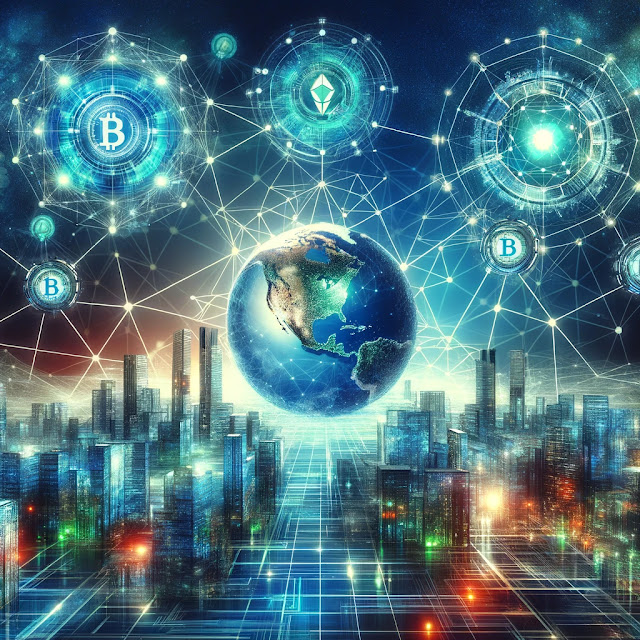Introduction:
Web3 represents the next phase of the
internet, promising a decentralized and user-centric online experience. Unlike
the current version of the internet (Web2), where data is controlled by central
authorities and big corporations, Web3 emphasizes user sovereignty and
peer-to-peer interactions. This article explores what Web3 is, how it works,
and what it could mean for the future of digital interactions.
What is Web3?
Web3 is the third generation of the
internet, where websites and apps operate on decentralized networks or
blockchains. This new phase does not rely on centralized servers or control
points, aiming instead to return ownership and control back to users. At its
core, Web3 uses technologies like blockchain, smart contracts, and token-based
economics to empower users to own and govern their digital assets.
Key Features of Web3:
- Decentralization:
Unlike Web2, where data is stored in centralized servers, Web3 data
resides on a blockchain, making it resistant to censorship and control by
a single entity.
- Token-Based
Economy: Web3 introduces an economic layer where users can earn tokens
for contributions like content creation or network maintenance, promoting
a more equitable internet.
- Privacy
and Security: Enhanced by blockchain technology, Web3 provides more
robust security features and better privacy, as user data isn't controlled
by centralized entities.
- Interoperability:
Web3 envisions a more interoperable internet where users can seamlessly
interact with multiple applications without needing separate accounts or
siloed data.
How Does Web3 Work?
Web3 operates through
decentralized applications (dApps) built on blockchains like Ethereum. These
dApps use smart contracts to automate transactions and interactions without the
need for intermediaries. Users interact with dApps using their digital wallets,
which serve both as an identity and a bank account, all controlled by the user.
The Potential of Web3:
The implications of Web3 are
vast and varied:
- For
Consumers: More control over personal data, potentially fewer ads, and
new ways to engage online.
- For
Developers: Freedom from platform constraints, opportunities to build
on open networks, and access to global markets without intermediaries.
- For
Business: New business models based on decentralization, and
challenges to traditional corporate structures.
Challenges and Considerations:
Despite its potential,
Web3 is not without challenges. Scalability issues, energy consumption of
blockchain technologies, and the steep learning curve for non-technical users
are significant hurdles. Additionally, regulatory responses to this new technology
remain uncertain and could impact its adoption and development.
FAQ Section:
1. Is Web3 the same as cryptocurrency?
No, while
cryptocurrency is a part of Web3, involving the use of digital tokens and
blockchain technology, Web3 encompasses a broader scope including decentralized
applications (dApps), smart contracts, and more aimed at creating a
decentralized web.
2. How can I start using Web3?
To start using Web3,
you need a digital wallet like MetaMask to interact with decentralized
applications. From there, you can explore dApps, participate in decentralized
finance (DeFi) systems, and more.
3. What are the risks of Web3?
The risks include the
volatility of cryptocurrency markets, potential security issues with smart
contracts, and regulatory uncertainties. It’s important to thoroughly research
and understand the risks before engaging deeply in Web3.
4. Can Web3 replace traditional internet applications?
While Web3 has the potential to offer alternatives to traditional internet
applications, it is unlikely to completely replace them in the near future.
Integration and coexistence with Web2 applications are more probable scenarios.
External References and Links:
- Ethereum
Foundation - Introduction
to Ethereum
- Learn
more about Ethereum, the leading blockchain platform for Web3
applications.
- MetaMask
- Getting Started with
MetaMask
- A
beginner’s guide to setting up a MetaMask wallet for interacting with
Web3.
- CoinDesk
- Web3 In-Depth Articles
- A
resource for deeper insights into the technical and economic aspects of
Web3.
- Decentralized
Web Summit - Exploring
the Future of the Web
- An
event that brings together developers, policymakers, and scholars to
discuss the future of the internet.
Conclusion: Web3 is an exciting development that
promises to reshape how we interact with the internet. By prioritizing
decentralization, user control, and an open economy, Web3 could potentially
usher in a new era of digital democracy. However, as with any emerging
technology, its success will depend on addressing its current limitations and
how effectively it integrates with the broader digital ecosystem.
Call to Action: To learn more about Web3 and its
evolving landscape, stay tuned for updates and dive into more specific aspects
of this technology in our upcoming posts.

